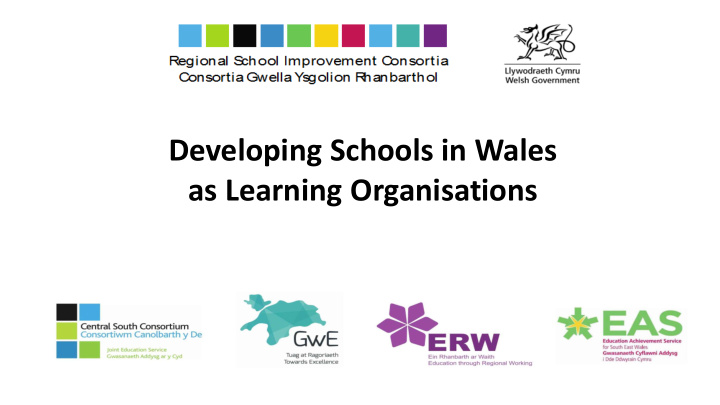



Developing Schools in Wales as Learning Organisations
The SLO model for Wales focuses on realising seven ‘dimensions’ in our schools. The seven action- oriented dimensions highlight the aspirational goals and processes to transform a school into a learning organisation.
SLO – EXPLORING THE SEVEN DIMENSIONS - DEVELOPING • • A shared and inclusive vision aims to Learners, parents/carers, the external enhance the learning experiences and community and other partners are outcomes of all learners. invited to contribute to the school’s vision. • The school’s vision focuses on enhancing learners’ cognitive and social-emotional outcomes (including their well-being), encompasses both the present and the future, and is inspiring and motivating. • Learning and teaching are oriented towards realising the vision. • The school’s vision is the outcome of a process involving all staff, including governors and other stakeholders. The SLOs vision is a motivating force for sustained action.
SLO – EXPLORING THE SEVEN DIMENSIONS - CREATING • • Professional learning challenges All staff engage in continuous thinking as part of changing practice. professional learning to ensure their practice is critically informed and up to • Professional learning connects work- date. based learning and external • expertise. New staff receive induction support. • • Professional learning is based on All staff have access to coaching and assessment and feedback from a mentoring support. range of sources including the • learner. Professional learning is focused on the learner’s learning and the school’s • Time and other resources are goals. provided to support professional • learning. Staff are fully engaged in identifying the aims and priorities for their own • The school’s culture promotes and professional learning. supports professional learning. The SLOs staff are responsible for their own professional learning.
SLO – EXPLORING THE SEVEN DIMENSIONS - PROMOTING • • Trust and mutual respect are core Collaborative working and collective values. learning – face-to-face and/or using ICT – are focused and enhance learning • The school allocates time and other experiences, learner outcomes and/or resources for collaborative working staff practice. and collective learning. • Staff reflect together on how to make their own learning more powerful. • Staff learn how to work together as a team. • Staff feel comfortable seeking advice from each other. Collaborative working and collective learning are central to the SLO.
SLO – EXPLORING THE SEVEN DIMENSIONS - ESTABLISHING • • Problems and failures are seen as Staff are willing to take risks and opportunities for learning. experiment and innovate in their practice. • Learners are actively engaged in • enquiry. The school supports and recognises staff for taking initiative and risks. • Staff engage in forms of enquiry to investigate and extend their practice. • Enquiry is used to establish and maintain a rhythm of learning, change and innovation. • Staff are open to thinking and doing things differently. SLOs uses enquiry to establish change and innovation in educational practice.
SLO – EXPLORING THE SEVEN DIMENSIONS - EMBEDDING • Staff have the capacity to analyse • Systems are in place to and use multiple sources of data examine progress and gaps for feedback, including ICT, to between current and expected inform teaching and allocate impact. resources. • Structures for regular dialogue • The school’s development plan is and knowledge exchange are in based on learning from place. continuous self-assessment and is updated at least once every year. • Examples of good and failed practices are made available to • Staff regularly discuss and all staff to inform learning. evaluate whether actions had the desired impact and change course • Sources of research evidence if necessary. are readily available and easily accessed and are used by staff • The school evaluates the impact to improve their practice. of professional learning. SLOs ensure they are “information -rich ” or, more appropriately, “knowledge rich”.
SLO – EXPLORING THE SEVEN DIMENSIONS - LEARNING • The school is an open system, • The school forms partnerships welcoming approaches from with higher education potential external collaborators. institutions, businesses, and/or public or non-governmental • The school scans its external organisations in efforts to environment to respond quickly deepen and extend learning. to challenges and opportunities. • Partnerships are based on • Staff collaborate, learn and equality of relationships and exchange knowledge with peers opportunities for mutual in other schools through learning. networks and/or school-to-school collaborations. • ICT is widely used to facilitate communication, knowledge • The school collaborates with exchange and collaboration with parents/carers and the the external environment. community as partners in the education process and the organisation of the school. SLOs exchange information and collaborate with the wider learning system.
SLO – EXPLORING THE SEVEN DIMENSIONS - MODELLING • School leaders ensure that the • School leaders develop the organisation’s actions are consistent culture, structures and conditions with its vision, goals and values. to facilitate professional dialogue, collaboration and knowledge • School leaders model learning exchange. leadership, distribute leadership and help grow other leaders, including • School leaders promote and learners. participate in strong collaboration with other schools, parents/carers, • School leaders are proactive and the community, higher education creative change agents with a strong institutions and other partners. focus on improving learning and teaching. • School leaders ensure an integrated approach to responding • School leaders ensure the school is to learners’ learning and other characterised by a ‘rhythm’ of needs. learning, change and innovation. Leadership is the essential ingredient connecting the seven SLO dimensions.
Recommend
More recommend